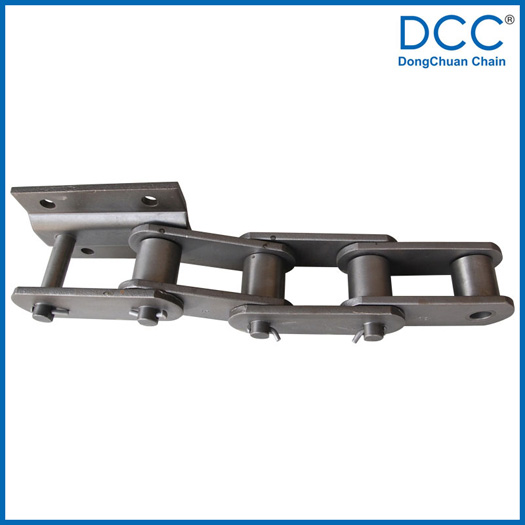- ADD:Hongzhuang Road, East Town Industry Area, Yaoguan Town, Wujin District, Changzhou City, Jiangsu Province, PR. China

- Mobile Phone:+86-15961181358
- Fax:+86-519-88700526
- E-mail:wk1358@dongchuan.cn
What Is the Difference Between Bucket Elevator Chain and Belt?
Have already visited 18102/21/2025
In the grain processing, mining and metallurgy, and building materials industries, bucket elevators are core equipment for vertical material transportation. The choice between their core transmission components-bucket elevator chains and belts directly affects equipment efficiency, maintenance costs, and service life. This article comprehensively analyzes the differences between the two from the perspectives of structural design, load-bearing capacity, applicable scenarios, and industry trends, providing a scientific basis for equipment selection, operation, and maintenance.
1.Structural Differences: Rigid Transmission vs Flexible Traction
Bucket Elevator Chains — Structural Characteristics
Bucket elevator chains consist of high-strength alloy steel links, pins, accessories (bucket hooks, etc.) and drive buckets to run through sprocket meshing. Their core advantages lie in:
Rigid Connection: Chains and buckets are connected by bolts or welding, there is no slippage in the transmission process, and it can be used in heavy-load and high-temperature working conditions.
Modular Architecture: Chain links can be replaced independently from one another, lowering maintenance costs.
Tensile Strength: The rupture strength of high-quality steel chains can exceed 800 kN, enabling them to handle distributions in applications where the lifted mass exceeds 50 m.

Composition and Limitations of Belts
Belts are usually composed of multiple layers of rubber, polyester fiber, or steel wire rope cores and rely on frictional force for driving. Their characteristics include:
Flexible Transmission: They are suitable for lightweight and dry materials (such as grains and wood chips), but are prone to efficiency reduction due to slipping.
Temperature Sensitivity: They are prone to aging and cracking in an environment above 60°C for a long time.
Length Limitation: The maximum length of a single belt segment is usually not more than 200 m, and it needs to be tensioned regularly.
2.Performance Comparison: Load-Bearing Capacity and Durability
Indicator | Bucket Elevator Chain | Belt |
Maximum Load | 2000 kg/m | 800 kg/m |
Temperature Resistance Range | −30°C ∼ 400°C | −10°C ∼ 80°C |
| Impact Resistance | High (metal structure buffers vibration) | Low (flexible material is easy to tear) |
| Service Life | 5-10 years (with regular lubrication) | 2 - 5 years (no wear repair) |
3.Applicable Scenarios: Precise Matching of Working Conditions Requirements
Scenarios Where Bucket Elevator Chains Are Preferred
Heavy and High-Temperature Materials: Such as cement clinker (with a temperature above 200°C) and ore fragments.
High Lifting Heights: The lifting height of mine shafts can reach 150 m, and the strength of the chain ensures stability.
Wet/Corrosive Environments: Galvanized or stainless steel chains are resistant to acid and alkali corrosion and are suitable for the transportation of chemical fertilizers and salt.
Scenarios Where Belts Are More Economical
Lightweight, Non-Abrasive Materials: Such as wheat and plastic pellets.
Low Noise Requirements: The running noise of rubber belts is more than 20 dB lower than that of steel chains, which is suitable for the environment in food factories.
Sensitive to Initial Costs: The installation cost of belt systems is about 30% lower than that of chains.
4. Maintenance Costs: The Trade-off of Long-Term Investment
Key Points of Chain Maintenance
Lubrication Cycle: Apply high-temperature grease every 500 hours to reduce pin wear.
Wear Monitoring: Replace the chain when the wear of the chain link thickness exceeds 10% or cracks appear.
Tension Adjustment: When the elongation of the chain exceeds 2%, it needs to be shortened or replaced to avoid tooth skipping.
Challenges in Belt Maintenance
Joint Risk: Glued or steel buckle joints are prone to becoming weak points and need to be inspected every 6 months.
Cleaning Requirements: Material residue can cause the belt to run off-track, increasing the cost of cleaners.
Sudden Breakage: The unexpected breakage of the belt may cause a full-line shutdown, with an average repair time of 8-24 hours.
5. Industry Trends: Technology Innovation Driving Choices
Lightweight and Intelligence of Chains
Material Upgrades: Titanium alloy chains reduce weight by 40% without sacrificing strength, adapting to high-speed elevators (above 3 m/s).
Real-Time Monitoring: Intelligent chains with built-in sensors can issue early warnings for wear and abnormal temperatures, reducing the unplanned shutdown rate.
Performance Breakthroughs of Belts
Aramid Fiber Reinforcement: The tensile strength of new belts has been increased to 500 N/mm, approaching the level of light-duty chains.
Self-Healing Coatings: Nano-coatings can automatically fill surface cracks, extending the service life by 30%.
6. Selection Guide: 5 Steps to Determine the Best Solution
Clarify material characteristics: particle size, humidity, temperature, and abrasiveness.
Calculate load requirements: hourly throughput (t/h) × lifting height.
Evaluate environmental factors: humidity, dust concentration, corrosive media.
Budget comparison: initial investment vs total maintenance cost over 10 years.
Supplier review: Give priority to manufacturers that have passed ISO 9001 certification and provide solutions adapted to working conditions.
Conclusion
The core differences between bucket elevator chains and belts stem from material characteristics and transmission logic. Chains, with their advantages of high strength and resistance to extreme environments, remain the top choice for heavy-load and high-temperature working conditions. Belts, on the other hand, are more economical in light-load and low-cost scenarios. With the integration of materials science and Internet of Things technology, the performance boundaries of the two are gradually blurring, but precisely matching the requirements of working conditions remains the key to the efficient operation of equipment. For users, selecting compliant suppliers and formulating preventive maintenance plans in combination with long-term operation and maintenance costs and production goals can maximize the life cycle value of equipment.







View More(Total0)Comment Lists